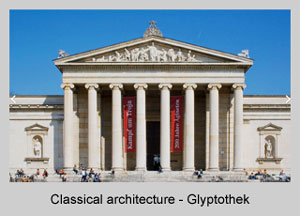Postmodern Architecture Explained
August 26, 2014
Overview
Like our other definitions of Postmodernism, Postmodern architecture gets its name as a successor to the modernist styles of the early twentieth century. Whereas modernist architecture was known for its formality and often cold, 'Brutalist' concrete, Postmodernism was heralded as the return of "wit, ornament and reference", where a larger emphasis was placed on aesthetics and form over function. New styles were mashed up with classical elements from the past in often unexpected, eclectic, and whimsical ways.
Classical Architecture
 Classical architecture refers to architecture from the ancient Greeks and Romans, as well as the styles deriven from them, including Neoclassical.
One of the distinguishing aspects of its construction is the use of ornate columns.
These columns are referred to by a design grammar known as orders.
The Greeks introduced the Doric, Ionic, and Corinthian orders, while the Romans introduced the Tuscan and Composite.
Classical architecture refers to architecture from the ancient Greeks and Romans, as well as the styles deriven from them, including Neoclassical.
One of the distinguishing aspects of its construction is the use of ornate columns.
These columns are referred to by a design grammar known as orders.
The Greeks introduced the Doric, Ionic, and Corinthian orders, while the Romans introduced the Tuscan and Composite.
During the Renaissance, the works of a Roman architect and engineer Vitruvius were used as the basis of newly developed architectural rule books. From there, classical architecture adapted and spread through Europe and the rest of the world. Starting around 1750, many architects tried to return to the original classical roots in a style known as Neoclassicism.
Modern Architecture
 The beginning of the 20th century saw rapid advances in technology and a major upheaval in society due to all of the changes it brought.
Architects during this period adopted the mantra of "Form follows function", where the aesthetics and design are secondary to the purpose of the building.
Rather than ornate classical columns and curves, modern architecture valued simplicity and square edges.
The hulking concrete and steel skeletons of buildings were made part of the visible design as opposed to hiding them behind facades.
Brutalist architecture evolved during this period and was popular form governmental and educational buildings.
The beginning of the 20th century saw rapid advances in technology and a major upheaval in society due to all of the changes it brought.
Architects during this period adopted the mantra of "Form follows function", where the aesthetics and design are secondary to the purpose of the building.
Rather than ornate classical columns and curves, modern architecture valued simplicity and square edges.
The hulking concrete and steel skeletons of buildings were made part of the visible design as opposed to hiding them behind facades.
Brutalist architecture evolved during this period and was popular form governmental and educational buildings.
Postmodern Architecture
 As described earlier, Postmodern architecture is a reaction and evolution to the modern architecture that came before it.
Not only did designers begin to make use of new innovations, but at the same time they appropriated design elements from the past.
Buildings became an eclectic mix of old and new as the old "Form follows function" mantra was forgotten.
One of the iconic postmodern examples is the Sony Building in New York City,
which contains a classical broken pediment for its top and is often compared to a "Chippendale" cabinet.
As described earlier, Postmodern architecture is a reaction and evolution to the modern architecture that came before it.
Not only did designers begin to make use of new innovations, but at the same time they appropriated design elements from the past.
Buildings became an eclectic mix of old and new as the old "Form follows function" mantra was forgotten.
One of the iconic postmodern examples is the Sony Building in New York City,
which contains a classical broken pediment for its top and is often compared to a "Chippendale" cabinet.
References in Literature
Interestingly, the tension between classical and modern architecture was captured in Ayn Rand's 1943 novel, The Fountainhead. Its protagonist and modern architect, Howard Roark, expresses his distaste for emulating classical design. His examples of appropriation, faux effects, and copies of copies of copies (progression of simulacra), also strangely foreshadow many postmodern themes as well
"Look,- said Roark. - The famous flutings on the famous columns – what are they there for? To hide the joints in wood – when columns were made of wood, only these aren’t, they’re marble. The triglyphs, what are they? Wood. Wooden beams, the way they had to be laid when people began to build wooden shacks. Your Greeks took marble and they made copies of their wooden structures out of it, because others had done it that way. Then your masters of the Renaissance came along and made copies in plaster of copies in marble of copies in wood. Now here we are, making copies in steel and concrete of copies in plaster of copies in marble of copies in wood. Why?"




